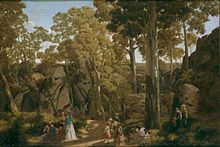- Hanging Rock, Victoria
-
Coordinates: 37°19′49″S 144°35′42″E / 37.330222°S 144.595083°E
Hanging Rock
A climber, bouldering a rockface on Hanging RockElevation 718 m (2,356 ft) AHD
(105 metres (344 ft) above plain)Prominence Low Listing Register of the National Estate[1] Location Location Victoria, Australia Range Macedon Geology Type Mamelon Age of rock 6.25 million years Climbing Easiest route Walk, sealed and unsealed tracks Hanging Rock (formally known as Mount Diogenes), in Central Victoria, Australia, is a distinctive geological formation, 718m above sea level (105m above plain level) on the plain between the two small townships of Newham and Hesket, approximately 70 km north-west of Melbourne and a few kilometres north of Mount Macedon, a former volcano. Best known as the site where a party of schoolgirls disappeared in February 1900 in the book Picnic at Hanging Rock, Hanging Rock is located within the Wurundjeri nation's territory.
Contents
Hanging Rock
Hanging Rock is a mamelon, created 6.25 million years ago by stiff magma pouring from a vent and congealing in place. Often thought to be a volcanic plug, it is not. Two other mamelons exist nearby, created in the same period: Camels Hump, to the south on Mount Macedon, and to the east, Crozier's Rocks. All three mamelons are made of solvsbergite, a form of trachyte only found in two or three other places in the world. As Hanging Rock's magma cooled and contracted, it split into rough columns. These weathered over time into the many pinnacles that can be seen today.
Hanging Rock contains numerous distinctive rock formations, including the 'Hanging Rock' itself (a boulder suspended between other boulders, under which is the main entrance path), the Colonnade, the Eagle and the UFO. The highest point on Hanging Rock is 718 metres above sea level and 105 metres above the plain below. Hanging Rock is located within the Wurundjeri nation's territory but they exercised a custodial responsibility on behalf of the surrounding tribes in the Kulin nation. It was a site of male initiation and as such entry was forbidden except those young males being taken there for ceremonial initiation. After colonial settlement the Aboriginal people of the area were quickly dispossessed and forced out of the area by 1844. However one last initiation ceremony was held there in approximately November 1851 by a Wurundjeri Elder from the Templestowe area in the Yarra Valley. This ceremony was also attended by two young settler's children, Willie Chivers aged eleven and his younger brother Tom Chivers aged seven, who were being cared for on a daily basis by the tribe after their mother had died.
The rock's official name, Mount Diogenes, was bestowed on it by Surveyor Robert Hoddle in 1844, in keeping with the spirit of several ancient Greek names given by Major Thomas Mitchell during his expedition through Victoria in 1836, which passed close to Hanging Rock. Others include Mount Macedon, Mount Alexander and the Campaspe River.[2]
Hanging Rock is the centrepiece for the Hanging Rock Recreation Reserve, a public reserve managed by the local government authority. The reserve also includes a forest, horserace track, picnic grounds, creek, interpretation centre and cafe. The reserve is a habitat for endemic flora and fauna, including koalas, wallabies, possums, wedge-tailed eagles and kookaburras. The reserve is open to the public during daylight hours seven days a week. Entry is charged per vehicle. Camping is possible by arrangement.
The Hanging Rock is now listed on the Register of the National Estate.[1]
Community
Horse races have been held at Hanging Rock for over one hundred years; the Hanging Rock Racing Club holds two race meetings a year on New Year's Day and Australia Day (26 January).[3]
Friends of Hanging Rock, started in 1987, is a community group which holds events open to the public, such as night walks and wildflower tours. The group can be contacted through the ranger.
Influence on the arts
Hanging Rock was the inspiration and setting for the novel Picnic at Hanging Rock, written by Joan Lindsay and published in 1967. The novel dealt with the disappearance of a number of schoolgirls during a visit to the Hanging Rock. Their disappearance was explained in the final chapter, but Lindsay deleted this chapter at the suggestion of her editor, thinking the mystery was greater without it.
The novel inspired the film Picnic at Hanging Rock, made in 1975 and directed by Peter Weir. The success of the film was responsible for a substantial increase in visits to the rock and a renewal of interest in the novel. Yvonne Rousseau wrote a book called The Murders at Hanging Rock, published in 1980, which examined possible explanations for the disappearance of the girls.
As a result of the increased interest, the deleted final chapter of the novel was finally published in 1987 as The Secret of Hanging Rock.
Gallery
References
- ^ a b "Hanging Rock, South Rock Rd, Newham, VIC, Australia (entry AHD4257)". Australian Heritage Database. Department of Sustainability, Environment, Water, Population and Communities. http://www.environment.gov.au/cgi-bin/ahdb/search.pl?mode=place_detail;place_id=4257. Retrieved 8 April, 2008.
- ^ Duncan, J.S, ed (1982). Atlas of Victoria. Melbourne: Victorian Government Printing Office. pp. 74 =. ISBN 0-7241-8255-1.
- ^ Country Racing Victoria. "Hanging Rock Racing Club". http://www.countryracing.com.au/index.php?option=com_club_info&club=59&Itemid=80. Retrieved 2009-05-07.[dead link]
External links
Categories:- Visitor attractions in Victoria (Australia)
- Rock formations in Australia
Wikimedia Foundation. 2010.






